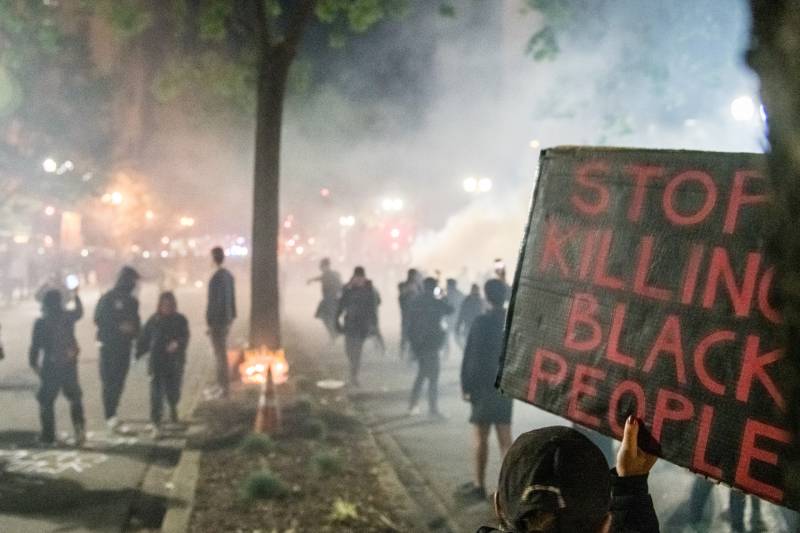“Seeds of that tactic also laid the groundwork for what came later,” Wasow said on KQED Forum. “The level of anger at that brutality by state actors, meant that there was a more militant wing of the Civil Rights Movement that emerged,” and they were more willing to use violence to defend themselves.
Then, like now, it was police violence against civilians that often started protests that would later become violent. In the summer of 1967, there were protests in more than a hundred cities in America. One of the most famous took place in Detroit after police raided a club. It sparked violent protests lasting five days. Forty-three people died.
As Matthew Green writes in his article, “Opportunity Lost: The 1968 Government Report on White Racism That America Chose to Ignore”:
The unrest stemmed from a deep-seated anger and hopelessness that had long simmered in many low-income, black and brown communities hobbled by systemic racism, where rates of poverty, police abuse, joblessness and crime were disproportionately high and opportunities for advancement few. Unlike in today’s demonstrations, those involved were almost unilaterally the black residents hardest hit.
“In the case of the [1960s] uprisings, and the case of the protests around the country today, the proximate cause is police violence,” said incoming Yale professor Elizabeth Hinton on Forum. “But really, these demonstrations are rooted in a call for greater socioeconomic inclusion and that is really what the mainstream Civil Rights Movement was championing at this time.”
Hinton says in 1968, America had a chance to do the right thing, but President Lyndon B. Johnson and other liberal lawmakers balked at what it would take. Following what has been dubbed “the long hot summer” of 1967, Johnson appointed the Kerner Commission, whose job it was to understand the root causes of uprisings.
The resulting report — titled “Report of the National Advisory Commission on Civil Disorders” — was a New York Times bestseller and put the blame squarely on institutionalized racism, inequality and poverty.*
“They really drew the nation’s attention to the role of white racism in fostering discrimination and in compelling the kind of anger and despair that so many residents in low income urban communities of color expressed in these incidents of collective violence that characterized the 1960s,” Hinton said.
The Kerner Commission laid out recommendations to prevent uprisings in the future, including massive investment in fundamental resources in urban communities. It said the root causes of civil unrest lay in unemployment, unequal access to education and systematic socioeconomic exclusion.
But those recommendations were largely ignored, the “War on Poverty” was inadequately funded and many of the problems the Kerner Commission laid out only got worse. Public opinion also shifted after the nation watched on television as cities like Detroit burned and protesters clashed with police in the streets.
“A violent protest today predicts a headline about riots, predicts public opinion saying crime and riots are the most important problem,” Wasow said.
Wasow’s research shows that shift may have had a decisive effect on the 1968 election, in which Richard Nixon and Hubert Humphrey were in a close race. Nixon, the law and order candidate, won and ushered in decades of policy that pumped money into policing, surveillance and incarceration.
“The biggest lesson we can learn is that we made this decision to manage the problem of failing schools, unemployment and dilapidated housing with police and with new surveillance technologies and locking people up and that has not worked,” Hinton said. “Now it’s time to try something new.”
*This article has been updated to reflect that the name of the Kerner Commission’s report is “Report of the National Advisory Commission on Civil Disorders,” not “The Harvest of American Racism.” The “Harvest of American Racism” was the first draft the team of social scientists submitted to the commission, which was too radical for many lawmakers, and was actively suppressed until recently. We regret the error.

